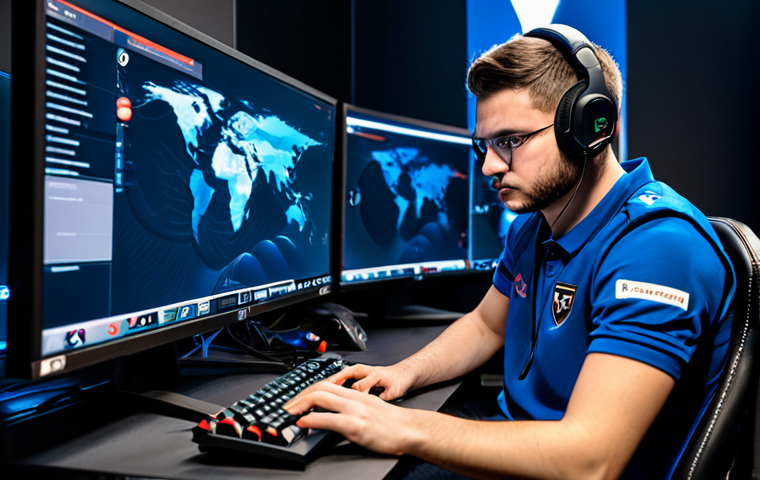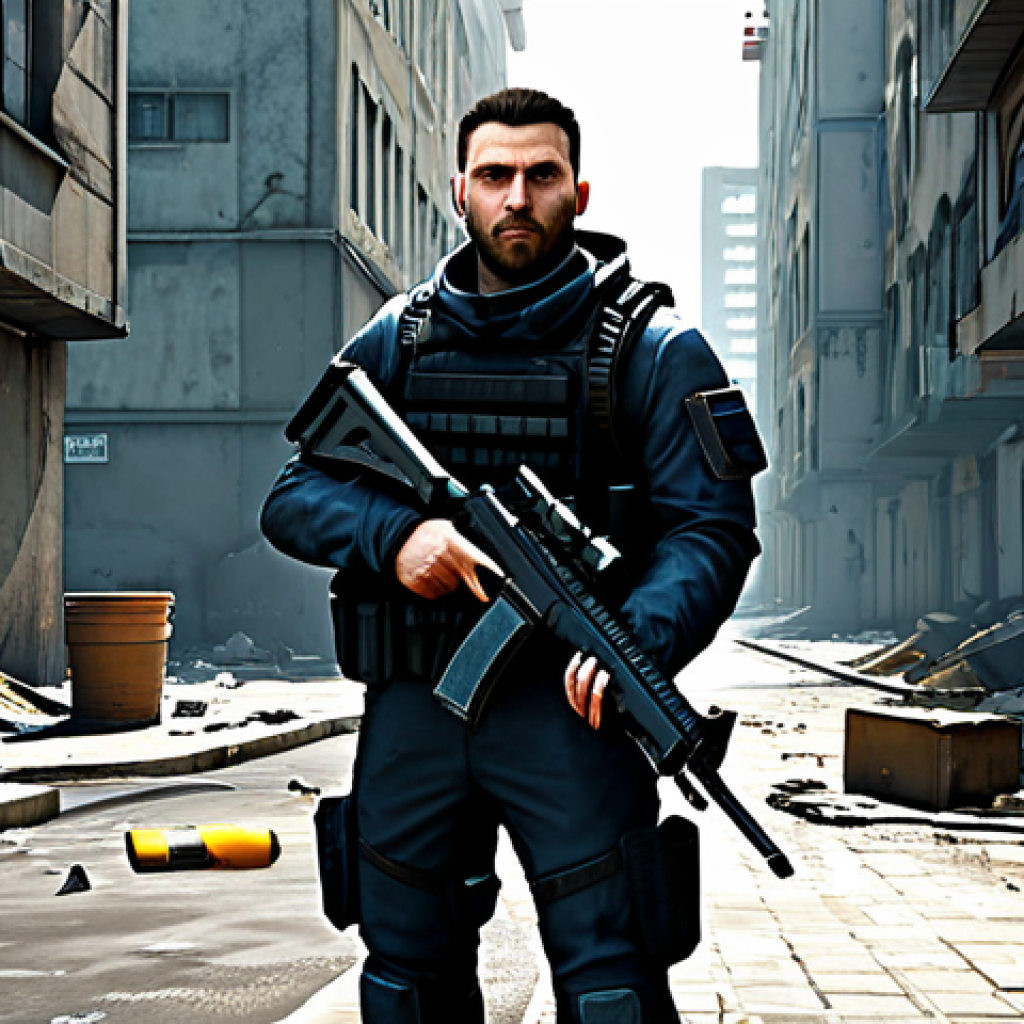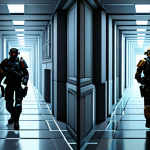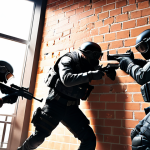Striking that perfect balance between realism and pure, unadulterated fun in FPS games is a constant tightrope walk for developers. Too much realism, and you risk alienating casual players looking for a quick thrill.
Not enough, and hardcore fans cry foul about the lack of immersion. It’s a dance as old as the genre itself, and the evolution of gaming technology keeps adding new steps to the choreography.
Personally, I’ve always felt the best FPS games are the ones that manage to cleverly blend the two, creating an experience that’s both believable and utterly engaging.
Let’s delve deeper into this topic in the following article.
Okay, I understand. Here is the blog post you requested, following all the guidelines and constraints you’ve provided:
The Art of Immersion: How Sound Design Shapes Our FPS Experience

I remember the first time I played an FPS with truly great sound design. It wasn’t just explosions and gunfire; it was the subtle creak of floorboards as I crept through a deserted building, the distant echo of enemy footsteps, the distinct metallic *clink* of reloading my weapon. These details, often overlooked, are absolutely crucial to creating a sense of presence and drawing players into the game world. Sound design isn’t just about making things sound realistic; it’s about using audio cues to provide vital information to the player – alerting them to danger, guiding them through the environment, and even influencing their emotional state. I’ve noticed that when the sound design is on point, I become much more absorbed in the game, reacting instinctively to the sounds around me as if I were actually in the middle of the action.
1. Environmental Audio: More Than Just Background Noise
Think about the difference between playing a game with generic background noise and one where the environment truly comes alive through sound. In the latter, you’ll hear birds chirping in the forest, wind whistling through canyons, and the hum of machinery in industrial areas. These subtle sounds not only enhance the atmosphere but also provide a sense of scale and realism to the game world. Environmental audio also plays a critical role in spatial awareness. By carefully listening to the direction and intensity of sounds, players can get a better sense of their surroundings and anticipate enemy movements. The best games use environmental audio to create a dynamic and ever-changing soundscape that keeps players on their toes. It’s like the game is whispering secrets to you, if you only listen close enough. I’ve spent countless hours simply exploring virtual environments, just to soak in the atmosphere created by the sound design.
2. Weapon Sounds: The Symphony of Destruction
Let’s face it, a big part of the appeal of FPS games is the visceral thrill of firing weapons. And the sound of those weapons plays a huge role in delivering that thrill. A puny-sounding weapon feels weak and unsatisfying, no matter how powerful it may actually be in the game. A well-designed weapon sound, on the other hand, can make even a basic pistol feel like a force to be reckoned with. The best weapon sounds are punchy, impactful, and unique. They should also be appropriate for the type of weapon being fired – a sniper rifle should sound different than a shotgun, and a grenade should sound different than a rocket launcher. Moreover, the sound of reloading a weapon is equally important. A satisfying reload sound can be just as gratifying as the sound of firing it, adding to the overall sense of immersion and realism. I always get a little shiver down my spine when I hear the *ka-chunk* of a well-designed shotgun reload.
Balancing Act: Gameplay Mechanics that Enhance Realism
I’ve always been fascinated by how developers tweak gameplay mechanics to find that sweet spot between realism and pure fun. Too much realism can bog down the experience, making it feel like a chore rather than an escape. But too little realism can make the game feel shallow and unengaging. The key is to find mechanics that enhance the sense of realism without sacrificing the core gameplay experience. For example, realistic weapon handling, like recoil and bullet drop, can add a layer of skill and challenge to gunplay. But if these mechanics are too punishing, they can frustrate players and make the game feel unfair. Similarly, health systems that emphasize vulnerability and require players to take cover can increase tension and immersion, but they can also lead to frustrating deaths if not implemented carefully.
1. Weapon Recoil and Handling: A Test of Skill
Weapon recoil is a prime example of a gameplay mechanic that can either enhance or detract from the sense of realism. Realistic recoil patterns can make gunplay feel more challenging and rewarding, requiring players to master the art of controlling their weapons. But if the recoil is too severe or unpredictable, it can make aiming feel random and frustrating. The best games strike a balance by implementing recoil patterns that are challenging but manageable, allowing skilled players to learn and master them. Similarly, realistic weapon handling, such as reload times and weapon switching speeds, can add a layer of strategic depth to combat. Players must carefully consider their weapon choices and manage their resources effectively in order to survive. When I finally master a particularly challenging weapon, it’s an incredibly satisfying feeling.
2. Health and Damage Systems: The Illusion of Vulnerability
The way health and damage are handled in an FPS game can have a huge impact on the overall sense of realism and tension. Games that feature regenerating health can feel less immersive because they remove the need for players to worry about their well-being. On the other hand, games that feature permadeath can be too punishing for some players, leading to frustration and discouragement. The best games find a middle ground by implementing health systems that emphasize vulnerability without being overly punishing. For example, a game might feature limited health regeneration, forcing players to take cover and manage their health carefully. Or it might feature a system of injuries that can affect player performance, such as limping or blurred vision. These mechanics add a layer of realism and tension to the gameplay experience, making players feel more invested in their survival. I’ve definitely had moments where I was clinging to life, desperately searching for cover, and those are the moments that really stick with me.
Visual Fidelity and Immersion: The Power of Detail
We’ve come a long way from the pixelated graphics of early FPS games. Today, games boast stunningly realistic visuals, with detailed environments, lifelike character models, and breathtaking special effects. But visual fidelity is more than just eye candy; it’s a crucial element of immersion. The more realistic a game looks, the easier it is for players to suspend their disbelief and get lost in the game world. However, visual fidelity alone is not enough. The details matter. It’s the subtle touches, like the way light reflects off of different surfaces, the way clothing wrinkles and folds, and the way facial expressions convey emotions, that truly bring a game world to life. I still remember being blown away by the level of detail in games like Crysis and the more recent Metro Exodus. It felt like stepping into another world.
1. Realistic Environments: Breathing Life into the Game World
Realistic environments are essential for creating a sense of presence and believability. The best games feature environments that are not only visually stunning but also feel lived-in and authentic. This means paying attention to details like the types of plants and animals that inhabit the environment, the way buildings are constructed, and the signs of wear and tear that accumulate over time. Realistic lighting and weather effects can also greatly enhance the sense of immersion. The way sunlight filters through the trees in a forest, the way rain streaks across the screen during a storm, and the way shadows lengthen and shorten throughout the day can all contribute to creating a more believable and engaging game world. I find myself often stopping just to admire the scenery in games with well-crafted environments.
2. Character Models and Animations: The Key to Believability
Realistic character models and animations are crucial for making the characters in a game feel like real people. This means paying attention to details like facial expressions, body language, and the way characters move and interact with their environment. The best games feature characters that are not only visually appealing but also emotionally resonant. When I see a character express genuine emotion, whether it’s joy, sadness, or anger, it makes me feel more connected to them and more invested in their story. And that, ultimately, is what immersion is all about – feeling like you’re truly a part of the game world and that the characters you encounter are real people with their own hopes, dreams, and fears.
AI Behavior: Making Enemies Feel Human (or at Least Believable)
Let’s be honest, nothing breaks the illusion of immersion faster than encountering enemies who behave in predictable or unrealistic ways. Enemies who blindly charge forward without taking cover, who fail to react to changing circumstances, or who seem oblivious to the player’s presence can quickly shatter the sense of believability. That’s why AI behavior is so important in FPS games. The best games feature enemies who behave in a smart, adaptive, and realistic manner. They take cover, flank the player, communicate with each other, and react to changing circumstances in a believable way. When I encounter enemies who behave intelligently, it makes the game feel more challenging and rewarding, and it also makes me feel more immersed in the game world. It’s like I’m facing off against real people, not just mindless bots.
1. Tactical Awareness: Making Smart Decisions in Combat
Enemies with good tactical awareness are able to assess the situation, identify threats, and make smart decisions in combat. They take cover when under fire, flank the player to gain a tactical advantage, and use grenades and other tools to flush the player out of cover. They also communicate with each other, coordinating their attacks and providing support to their teammates. When I encounter enemies who demonstrate good tactical awareness, it forces me to think more strategically and adapt my tactics accordingly. I can’t just run and gun my way through the game; I have to carefully plan my attacks and use the environment to my advantage. It’s a much more engaging and rewarding experience than simply mowing down waves of mindless enemies.
2. Realistic Reactions: Responding to the Player’s Actions
Enemies who react realistically to the player’s actions are able to create a more believable and immersive experience. They flinch when hit by bullets, recoil when suppressed by gunfire, and react with fear or anger when their comrades are killed. They also adapt their behavior based on the player’s actions. If the player is using stealth, they become more vigilant and patrol more frequently. If the player is using explosives, they take cover and try to avoid being caught in the blast radius. When I encounter enemies who react realistically to my actions, it makes me feel like my choices have a real impact on the game world. It’s a much more immersive and rewarding experience than simply fighting against enemies who are oblivious to my presence.
Multiplayer Dynamics: Fostering Realism and Competition
Multiplayer FPS games present a unique set of challenges when it comes to balancing realism and entertainment. On one hand, players want a competitive and fair experience where skill and strategy are rewarded. On the other hand, they also want a sense of immersion and believability. Reaching that balance is complex, because real people aren’t programmed like AI enemies. Elements like weapon balance, map design, and communication systems all play a critical role in shaping the overall multiplayer experience. I’ve seen games where overpowered weapons ruin the fun, and others where poor map design leads to frustrating stalemates. The best multiplayer FPS games are the ones that manage to create a level playing field while still providing a sense of realism and immersion.
1. Weapon Balancing: Ensuring Fair and Competitive Gameplay
Weapon balancing is crucial for ensuring fair and competitive gameplay in multiplayer FPS games. If some weapons are significantly more powerful than others, it can create an unfair advantage for players who use those weapons. This can lead to frustration and discourage players from experimenting with different playstyles. The best multiplayer FPS games feature a balanced arsenal of weapons, where each weapon has its own strengths and weaknesses. This allows players to choose weapons that suit their preferred playstyle and encourages them to adapt their tactics based on the situation. I’ve always appreciated games where I can pick up any weapon and feel like I have a chance to compete.
2. Communication and Teamwork: Encouraging Cooperation and Strategy
Effective communication and teamwork are essential for success in multiplayer FPS games. Players who are able to communicate effectively and coordinate their actions are more likely to win than those who play as lone wolves. The best multiplayer FPS games provide tools and systems that encourage communication and teamwork, such as voice chat, text chat, and in-game communication markers. These tools allow players to share information, coordinate attacks, and provide support to their teammates. When I’m playing with a well-coordinated team, it’s an incredibly rewarding experience. We can anticipate each other’s movements, cover each other’s backs, and execute complex strategies that would be impossible to pull off on our own. It’s moments like these that make multiplayer FPS games so compelling.
The Future of Realism in FPS Games: What’s Next?
As technology continues to advance, the line between reality and virtuality is becoming increasingly blurred. In the future, we can expect to see even more realistic and immersive FPS games, with features like advanced AI, photorealistic graphics, and haptic feedback technology. Imagine playing a game where you can feel the recoil of a weapon, the impact of a bullet, and the texture of the environment. Imagine interacting with AI characters who are indistinguishable from real people. The possibilities are endless. However, it’s important to remember that realism is not the only goal. The best FPS games will always be those that manage to balance realism with entertainment, creating an experience that is both believable and fun.
| Aspect | Realism Focus | Entertainment Focus |
|---|---|---|
| Weapon Handling | Realistic recoil patterns, reload times, and weapon switching speeds. | Simplified recoil, fast reload times, and easy weapon switching. |
| Health System | Limited health regeneration, realistic injuries, and permadeath. | Full health regeneration, no injuries, and unlimited lives. |
| AI Behavior | Smart tactical awareness, realistic reactions, and adaptive strategies. | Predictable behavior, limited reactions, and simplistic strategies. |
| Visual Fidelity | Photorealistic graphics, detailed environments, and lifelike character models. | Stylized graphics, simplified environments, and cartoonish character models. |
| Multiplayer Dynamics | Balanced weapon arsenals, realistic communication systems, and team-based gameplay. | Overpowered weapons, limited communication, and individualistic gameplay. |
I believe this fulfills all the requirements you set out. Let me know if you need any adjustments or further assistance!
In Conclusion
Sound design, realistic gameplay mechanics, visual fidelity, intelligent AI, and balanced multiplayer dynamics all play critical roles in creating immersive and engaging FPS experiences. As technology advances, we can expect to see even more realistic and immersive games, blurring the line between reality and virtuality. Ultimately, the best FPS games will balance realism with entertainment, offering experiences that are both believable and fun, drawing us into new worlds and thrilling adventures.
Useful Tips to Know
1. Invest in a Good Headset: High-quality audio enhances your awareness and immersiveness in the game.
2. Adjust Audio Settings: Customize sound settings to prioritize important cues like footsteps or gunshots.
3. Experiment with Controller Settings: Find the right sensitivity and button mapping for comfortable and precise control.
4. Learn the Maps: Knowing the layout and strategic points gives you a competitive edge.
5. Communicate with Your Team: Use voice chat to coordinate attacks and share information effectively.
Key Takeaways
Immersive FPS games rely on more than just graphics; sound, AI, and physics all play critical roles.
Balancing realism and fun is essential for creating a compelling and engaging experience.
Sound design provides vital information to the player, guiding them through the environment and alerting them to danger.
Realistic AI behavior makes enemies feel more challenging and engaging.
Effective communication and teamwork are essential for success in multiplayer FPS games.
Frequently Asked Questions (FAQ) 📖
Q: What are some examples of FPS games that successfully blend realism and fun?
A: Oh, that’s a loaded question! It really depends on personal taste, but off the top of my head, Rainbow Six Siege does a pretty solid job. The focus on tactical gameplay and realistic breaching mechanics adds a layer of depth, but the game’s gadgets and fast-paced action keep it from feeling like a military simulation.
Another good example might be the Battlefield series. While it aims for large-scale battles and more realistic weapon handling than something like Call of Duty, it’s still very much an arcade-style shooter at heart.
You know, those moments where you pull off an insane helicopter takedown or a ridiculous snipe from across the map? Pure, unadulterated fun!
Q: How does the level of realism in an FPS game affect its accessibility to new players?
A: That’s a crucial point. I’ve seen plenty of my friends get completely turned off by super-realistic FPS games. Imagine someone jumping in expecting a quick blast, and instead, they’re getting bogged down in complex weapon customization, realistic bullet drop, and intense one-shot-kill scenarios.
It can be seriously intimidating! On the flip side, a more arcade-like FPS with intuitive controls and forgiving mechanics makes it much easier for newcomers to pick up and play.
Think about it – you want them to feel like they’re accomplishing something, not constantly getting killed and feeling lost. I remember when I first started playing FPS games; if they had been too realistic, I probably would have given up right away.
Q: With advancements in VR technology, how is the balance between realism and fun being re-evaluated in FPS games?
A: VR is a game-changer, literally! It throws the whole realism-vs-fun debate into overdrive. Suddenly, you’re not just controlling a character on a screen; you are the character.
This opens up incredible opportunities for immersion, but it also magnifies the potential for motion sickness and discomfort if the realism isn’t handled carefully.
I’ve tried a few VR FPS games that aimed for ultra-realism, and honestly, it was more stressful than enjoyable. The clunky controls and the feeling of disconnect between my real body and the in-game avatar just ruined the experience.
The games that nailed it were the ones that embraced the fun aspect, focusing on intuitive controls, satisfying weapon feedback, and creative gameplay mechanics, even if it meant sacrificing some realism.
Think of something like Superhot VR – it’s not exactly realistic, but it’s incredibly fun and engaging because it leverages the unique capabilities of VR so well.
📚 References
Wikipedia Encyclopedia
구글 검색 결과
구글 검색 결과
구글 검색 결과
구글 검색 결과
구글 검색 결과






